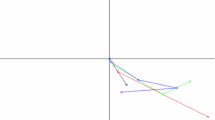Abstract
We construct a stationary random tree, embedded in the upper half plane, with prescribed offspring distribution and whose vertices are the atoms of a unit Poisson point process. This process which we call Hammersley’s tree process extends the usual Hammersley’s line process. Just as Hammersley’s process is related to the problem of the longest increasing subsequence, this model also has a combinatorial interpretation: it counts the number of heaps (i.e. increasing trees) required to store a random permutation. This problem was initially considered by Byers et al. (ANALCO11, workshop on analytic algorithmics and combinatorics, pp 33–44, 2011) and Istrate and Bonchis (Partition into Heapable sequences, heap tableaux and a multiset extension of Hammersley’s process. Lecture notes in computer science combinatorial pattern matching, pp 261–271, 2015) in the case of regular trees. We show, in particular, that the number of heaps grows logarithmically with the size of the permutation.


















Similar content being viewed by others
References
Aldous, D., Diaconis, P.: Hammersley’s interacting particle process and longest increasing subsequences. Probab. Theory Relat. Fields 103(2), 199–213 (1995)
Aldous, D., Diaconis, P.: Longest increasing subsequences: from patience sorting to the Baik–Deift–Johansson theorem. Bull. Am. Math. Soc. 36(4), 413–432 (1999)
Baik, J., Deift, P., Johansson, K.: On the distribution of the length of the longest increasing subsequence of random permutations. J. Am. Math. Soc. 12(4), 1119–1178 (1999)
Basdevant, A.-L., Enriquez, N., Gerin, L., Gouéré, J.-B.: Discrete Hammersley’s lines with sources and sinks. ALEA 13(1), 33–52 (2016)
Byers, J., Heeringa, B., Mitzenmacher, M., Zervas, G.: Heapable sequences and subsequences. ANALCO11, Workshop on Analytic Algorithmics and Combinatorics, pp. 33–44 (2011)
Cator, E., Groeneboom, P.: Hammersley’s process with sources and sinks. Ann. Probab. 33(3), 879–903 (2005)
Groeneboom, P.: Hydrodynamical methods for analyzing longest increasing subsequences. J. Comput. Appl. Math. 142, 83–105 (2002)
Hammersley, J.M.: A few seedlings of research. In: Proceedings of the Sixth Berkeley Symposium on Mathematical Statistics and Probability, vol. 1, pp. 345–394 (1972)
Istrate, G., Bonchis, C.: Partition into Heapable Sequences, Heap Tableaux and a Multiset Extension of Hammersley’s Process. Lecture Notes in Computer Science Combinatorial Pattern Matching, pp. 261–271 (2015)
Kingman, J.F.C.: Subadditive ergodic theory. Ann. Probab. 1(6), 883–899 (1973)
Logan, B.F., Shepp, L.A.: A variational problem for random Young tableaux. Adv. Math. 26(2), 206–222 (1977)
Romik, D.: The Surprising Mathematics of Longest Increasing Subsequences. Cambridge University Press, Cambridge (2015)
Seppäläinen, T.: Increasing sequences of independent points on the planar lattice. Ann. Appl. Probab. 7(4), 886–898 (1997)
Seppäläinen, T.: Exact limiting shape for a simplified model of first-passage percolation on the plane. Ann. Probab. 26(3), 1232–1250 (1998)
Veršik, A.M., Kerov, S.V.: Asymptotic behavior of the Plancherel measure of the symmetric group and the limit form of Young tableaux. Dokl. Akad. Nauk SSSR 233(6), 1024–1027 (1977)
Acknowledgements
The authors warmly thank Nathanaël Enriquez for stimulating discussions on the topic.
Author information
Authors and Affiliations
Corresponding author
Rights and permissions
About this article
Cite this article
Basdevant, AL., Gerin, L., Gouéré, JB. et al. From Hammersley’s lines to Hammersley’s trees. Probab. Theory Relat. Fields 171, 1–51 (2018). https://doi.org/10.1007/s00440-017-0772-2
Received:
Published:
Issue Date:
DOI: https://doi.org/10.1007/s00440-017-0772-2
Keywords
- Hammersley’s process
- Heap sorting
- Patience sorting
- Longest increasing subsequences
- Interacting particles systems




